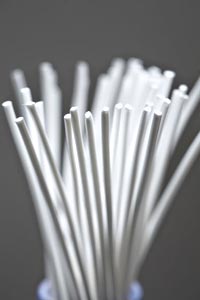UF/MF basics
 Ultrafiltration on hollow fiber membrane is a clean, efficient and inexpensive technique for drinking water production, process water production, tap water purification, waste water treatment for recycling/reuse, pretreatment to desalination and other specific applications.
Ultrafiltration on hollow fiber membrane is a clean, efficient and inexpensive technique for drinking water production, process water production, tap water purification, waste water treatment for recycling/reuse, pretreatment to desalination and other specific applications.
Ultrafiltration often replaces other more conventional treatment techniques and microfiltration as well, as it has the capacity to eliminate not only small particles but also pathogenic germs including microorganisms, viruses, pyrogen and some dissolved organic species.
Membrane
A hollow fiber membrane is a small plastic tube less than one millimeter in diameter, whose wall is porous.
The pores of S2 Polymem membranes are 0,01 µm size, that is to say 10,000 times thinner than a human hair. Suspended matters, but also micro-organisms and viruses perfectly retained on the surface of the fibers (the smallest micro-organisms and viruses have sizes of 0.2µ and 0.025 µ respectively).
Modules
The Polymem ultra filtration cartridges are composed of several thousands of these fibers and offer a huge filtration surface for large volumes treatment.
 How it works
How it works
UF is a purely physical treatment able to treat any kind of water with the same purifying efficiency. Ultrafiltration is a process where the driving force is the pressure of the liquid to be treated (0.5 to 1.5 bars). Pressurized water enters the module and treated water (called filtrate or permeate) passes through the membrane barrier. The retained substances are captured on the membrane surface and continuously or periodically removed from the module, depending on the filtration mode (cross flow or dead end), in the concentrate or in the backwash effluent. The pore size is about one hundredth of a micron, allowing the retention of very small particles, providing a permeate turbidity of the less than 0.1 NTU, but also of micro-organisms and viruses (disinfection), of pyrogens…
The porous structure of membranes presents a very thin layer called “skin” on the filtration surface, with the smallest pores, while the rest of the thickness (more than 100 μ) has pore diameters of about a micron. The “skin” ensures the retention capacity while the internal structure of the fiber allows an easy passage of the filtrate.
Ultrafiltration is thus a filtration “on the membrane surface”, unlike microfiltration which is a “depth filtration” (MF pore size is the same over the entire thickness of the fiber).
 Why to choose ultrafiltration ?
Why to choose ultrafiltration ?
Ultrafiltration is chosen for an excellent and permanent efficiency of treatment
Ultrafiltration clarifies and disinfects the water in one step. Ultrafiltration is an alternative to conventional filtration for water clarification, with a significant improvement in the effectiveness of treatment (reduction of the turbidity to less than 0.2 NTU) which is obtained regardless of the quality of raw water treated and without chemicals addition. Ultrafiltration often replaces other more conventional treatment techniques and microfiltration as well, as it has the capacity to eliminate not only small particles but also pathogenic germs including microorganisms, viruses, pyrogen and some dissolved organic species.
Ultrafiltration enables the treatment of waters with up to 300 mg/l total suspended solids (TSS) in pressurized filtration mode, and up to 15 g/l in suction mode (membrane bioreactors).
– Natural Fresh Water
- Source water, underground water
- Lake water
- River water
– Natural Salted Water
- Sea water
- Brackish water
– Wastewater ; urban, domestic and industrial
- Raw (membrane bioreactors)
- Pre-treated (tertiary treatment)
– Effluent concentration
- Dairy
- Textile effluents
- Wines
- …
![]()
FAQ
Why to choose Inside/Out or Outside/In ?
 Inside/Out filtration was originally developed for fluids concentration (when the valuable stream is the concentrate). This mode is recommended when cross flow filtration is required due to high concentration of organic matter and when the concentrate is the final product (concentration process).
Inside/Out filtration was originally developed for fluids concentration (when the valuable stream is the concentrate). This mode is recommended when cross flow filtration is required due to high concentration of organic matter and when the concentrate is the final product (concentration process).
The Outside / In filtration is particularly advantageous for natural water treatment (fresh water or sea water) and for wastewater (membrane bioreactors or tertiary treatment) because it offers:
– Higher membrane area in a smaller volume
– No risk of fiber plugging
– Easier backwashing (with air scour)
– Simpler process thanks to dead end filtration mode (successive steps of filtration and backwash)
– Simpler modules with only two connections leading to simpler and cheaper systems with less piping
Ultra or Micro Filtration ?
For short term applications (disposable cartridges), microfiltration offers the advantage of a higher filtration flux (liters of water passing through the membrane per hour and per square meter).
For long term applications (municipal, industrial) ultrafiltration is preferred to microfiltration because for the same investment and operating cost, it offers:
– similar fluxes (after a few weeks or months of operatio, ultrafiltration and microfiltration fluxes become similar).
– 4 log and more viruses removal in all cases (regardless of viruses size) when microfiltration will remove 1 to 4 log.
– a SDI removal which is much better with ultrafiltration than with microfiltration.
Which membrane for which filtration ?
| Objective | Process pressure | Filtration type | Pore size |
|---|---|---|---|
| Clarification, primary disinfection | Low pressure | Microfiltration | 0.1 µ to 1 µ |
| Clarification, virus disinfection, Nanofiltration or Reverse Osmosis pretreatment | Low pressure | Ultrafiltration | 0.005 µ to 0.1 µ |
| Organic molecules and large ions retention, COD removal, color removal, partial desalination, softening, desulfation,.. | High pressure | Nanofiltration | <0.005 µ |
| Desalination, demineralization | High pressure | Reverse Osmosis | Water is passing by diffusion through a dense membrane while ions and small organic species are rejected |
